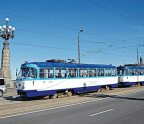
What defines a railway / railroad? By definition, it is the rails and the National Railway Museum located in the Adelaide suburb of Port Adelaide is uniquely placed to exhibit not only a world class collection of locomotives, railcars and rolling stock from throughout Australia, but because of Australia’s much ridiculed railway history, unique and operational examples of the rails on which they ran.
Australia was cursed with three operating mainline rail gauges, based around the whims of the colonies. South Australia and the neighbouring colony in Victoria, opted for the Irish Broad Gauge of 5’3” (1600 mm). The founding colony of Australia, New South Wales, opted eventually for the standard 4’8½” (1435 mm), after originally indicating preference for the Irish broad gauge being utilised in the two southern states, while Western Australia and Queensland opted for the narrow gauge of 3’6” (1067 mm). This ultimately made inter colony connectivity particularly awkward, necessitating changing of trains and trans-shipment of freight at the borders. Add into this, South Australia also adopted the narrow gauge for operations in the lesser utilised areas of the state, much like the Denver & Rio Grande and Denver & Rio Grande Western relationship in the USA. Lines under the control of the Federal Government, opted for the standard gauge. It wasn’t until 1970 that there was a single unifying trans-continental standard gauge east-west rail connection, best known for the Indian Pacific passenger train.
Brief History of the South Australian Railways
To better appreciate the collection on display, a brief history of the railways in Australia and South Australia in particular is helpful. The first railway in Australia opened in South Australia on 26 May 1854, barely 20 years after the founding of the free colony, (linking the ports of Goolwa and Port Elliot), unless of course, like the Victorians in the adjoining state, you believe that a railway must be locomotive drawn, not horse, then the first railway opened was the Melbourne to Sandridge (Port Melbourne) line in Septemberconsidered large locomotive power. The railways were failing and the state government decided evolution was needed and a new Chief Commissioner was appointed. Enter American William Alfred Webb. Formerly of the Colorado Midland, Missouri, Kansas and Texas (The Katy) and with his wide depth of experience, he was sought out by the United States Railroad Administration when the US entered World War I. Webb brought an American business operating philosophy unlike anything seen previously and he set about modernising the infrastructure and culture of the SAR.






